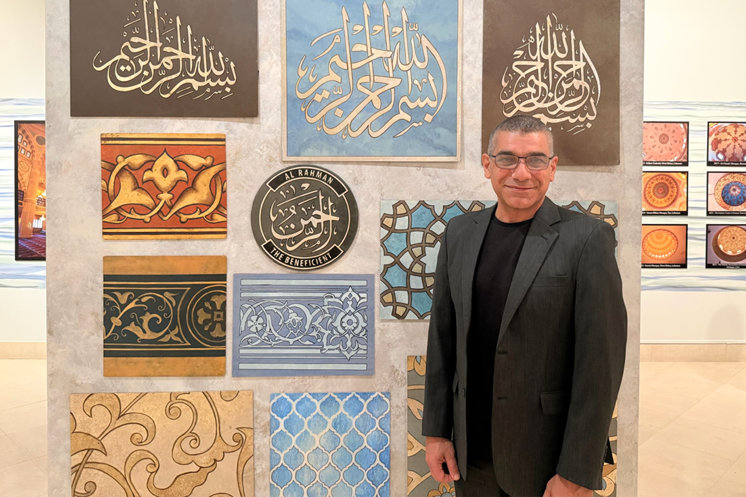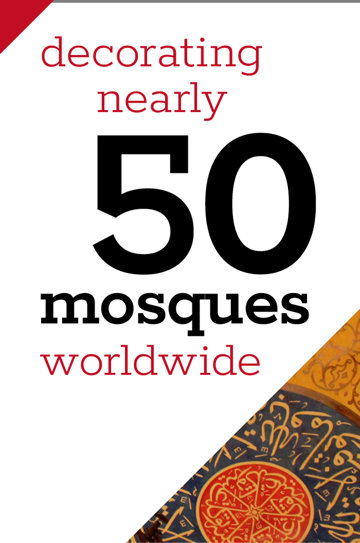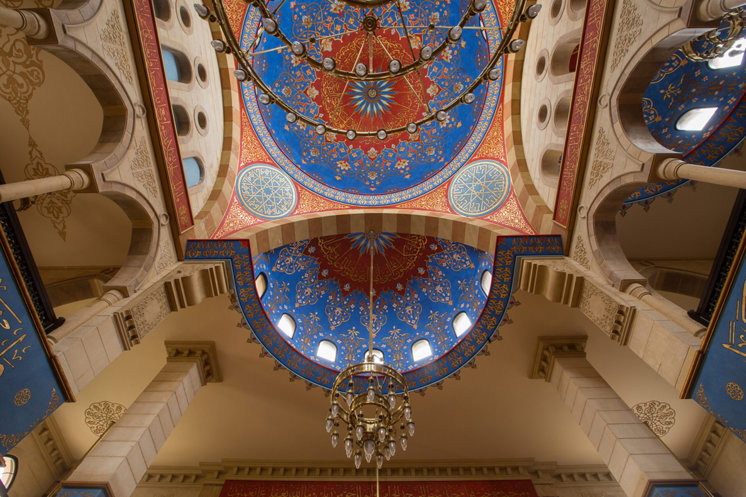Bastajian, a highly talented muralist, is a practicing Christian. But, unexpectedly, he spends his days bringing vivid life to the towering, decorative domes of Islamic mosques.
In this way, he is a living example of two seemingly divergent faiths flourishing in coexistence—a delicate balance Bastajian manages wonderfully.
“God works in mysterious ways, bring[ing] us all together to decorate His house of worship,” Bastajian says.
In a new exhibition at the Arab American National Museum in Michigan entitled “The Art of Spiritual Enlightenment,” images of Bastajian’s domework decorate the walls for visitors to admire. (The actual domes, covering thousands of square feet, could never be brought into the museum.)

“Since my early childhood, I have been interested in dangerous sports and art. I trained in both mountaineering and arts, being a professional paragliding pilot with no fear of heights,” Bastajian said. “I [have] combined my passion of adventure and art in huge projects.”
Today, his work decorates nearly 50 mosques around the world, including Mohammad Al-Amin (the largest mosque in Lebanon), the Islamic Association of Greater Detroit (IAGD) (one of the largest mosques in North America) and Nigeria’s Ilorin Mosque.
“It’s a lesson in caring,” said museum curator Mark Mulder in describing Bastajian’s artistry. It proves, Mulder continued, “that you don’t have to belong to a group to learn about them, to understand them and to care about them.”
The similarity of Bastajian’s art to the Vatican’s Sistine Chapel has earned Bastajian the nickname “Michelangelo of Mosques.” But with typical humility, he rejects the comparison with a laugh, saying, “Michelangelo—he’s of another level.”

Before beginning each project, Bastajian first studies the bare dome from the ground, where Islamic worshippers will visualize and glory in it. Then he starts planning.
Mosque domes typically avoid human figures, instead relying on Arabic calligraphy, Quranic verses and vibrantly colorful geometric designs intended to remind worshippers of Allah.
“God created this world filled with beauty and harmony. And calligraphy and floral representation can connect a person with God,” Zulfiqar Ali Shah, the director of religious affairs at IAGD, said. “When you enter a mosque, the coloring scheme, the carpet, the woodwork, the calligraphy—all of them take you away and you transcend the concerns of the material world.”
“God works in mysterious ways, bring[ing] us all together to decorate His house of worship,” Bastajian says.
As a child in Lebanon, Bastajian would accompany his mother to church for mass. Across the street was a mosque. After mass, he would visit friends there and play, absorbing an early lesson in peaceful coexistence between faiths.
“I somehow grew up in the part of Lebanon during the war where Christians [and] Muslims lived in harmony,” he said.
“Unlike what the mass media shows of the unfortunate ugly picture of war and terror, the earth is full of good people.”
In addition to mosques, Bastajian has restored a number of Christian sites, among them a 19th-century Roman church and an 18th-century Armenian monastery in Lebanon.
One of the first visitors to the Michigan exhibition was Bastajian’s friend, Father Hrant Kevorkian, pastor of St. Sarkis Armenian Apostolic Church. “It’s his passion,” he said of Bastajian. “It’s a God-given gift that he wants to give back to God, and that’s how I see it.”
Father Kevorkian noted that Bastajian is currently designing a cross for his church.
Bastajian’s career began, ironically enough, with a basketball.
He had worked on the home of the prominent Hariri family in Lebanon and, in 2004, impressed with his artistry, they asked him to tackle the dome of a new mosque in Sidon.
“When I went in and saw the huge dome, which is like 900 square meters, I couldn’t sleep that night. I was thinking, ‘How am I supposed to do this?’”
But playing basketball later on, he noticed the divisions in the ball’s surface, and realized he could break up the mosque’s dome into segments, and do the project in parts.
Suddenly, it was easy.

“Within two months I was able to finish the project with my team,” he said.
Nearly 50 more mosques would follow. Bastajian had found a new calling.
“I am doing something for the house of God,” he said, “not somebody’s [private] house.”
With his wife and six children, Bastajian has relocated to Dearborn, Michigan, home to the largest Muslim population per capita in the United States.
“The community and the family I lived with at the Islamic Center of America in Dearborn, Michigan, left a life-changing impact in my heart,” Bastajian said. “There I met the purest hearts ever, whose main purpose in life is to spread love and happiness around them.
“Unlike what the mass media shows of the unfortunate ugly picture of war and terror, the earth is full of good people,” he said. “We live with each other, understand each other and … this simple act of accepting each other is beyond any certain philosophy.
“Regardless of their religion, people are good and pray to the same God from different perspectives.”






















